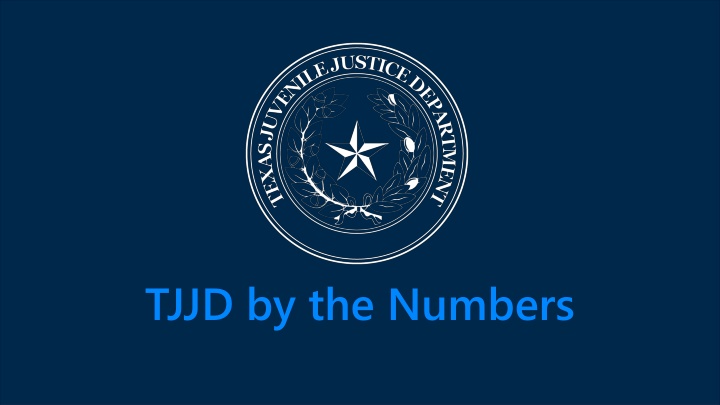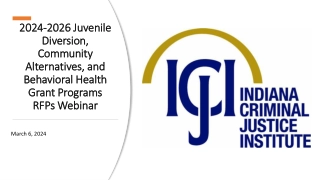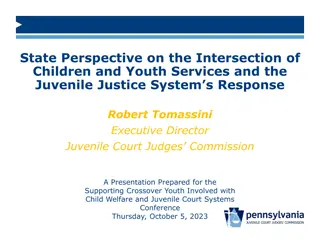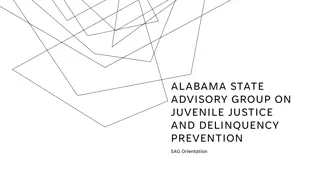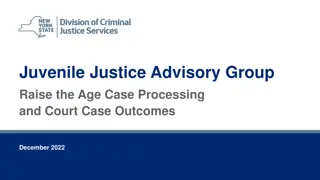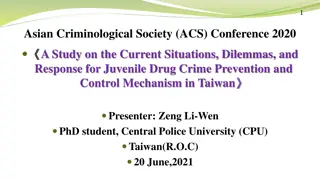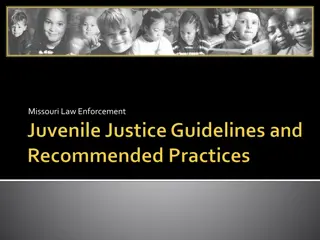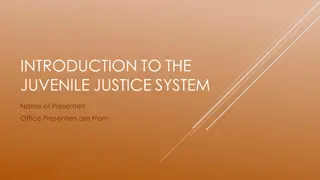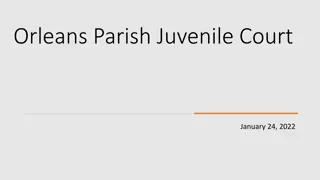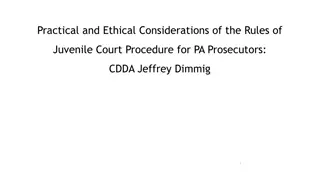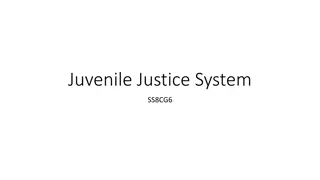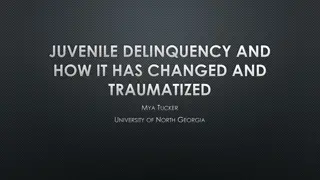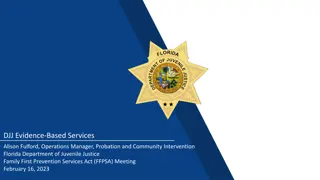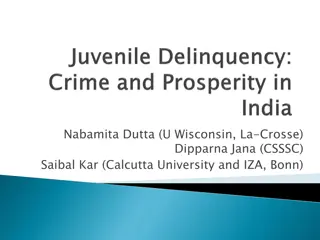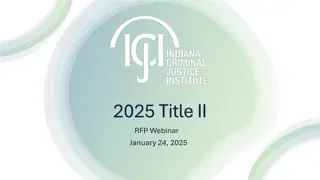TJJD by the Numbers: Juvenile Justice Trends Revealed
In this insightful data analysis, explore the key trends in the Texas Juvenile Justice Department (TJJD) from FY 2010 to 2023. Discover how formal referrals, probation supervision, and felony referrals have evolved, as well as the impact of the pandemic on juvenile justice dynamics. Uncover the shifts in homicide, firearms, and felony drug offense referrals, and how diversion efforts have influenced residential placements. Delve into the stabilization of adult certification and TJJD commitment dispositions post-pandemic.
Download Presentation

Please find below an Image/Link to download the presentation.
The content on the website is provided AS IS for your information and personal use only. It may not be sold, licensed, or shared on other websites without obtaining consent from the author.If you encounter any issues during the download, it is possible that the publisher has removed the file from their server.
You are allowed to download the files provided on this website for personal or commercial use, subject to the condition that they are used lawfully. All files are the property of their respective owners.
The content on the website is provided AS IS for your information and personal use only. It may not be sold, licensed, or shared on other websites without obtaining consent from the author.
E N D
Presentation Transcript
From FY 2010 2020, the overall size of the juvenile justice system declined nationwide Total Delinquency Cases in Juvenile Courts - Nationwide Total Formal Referrals to Texas Probation Departments TJJD Youth Average Daily Population (Facility + Parole) 1,324,000 3,492 85,958 40,781 508,400 1,224 Fiscal Year Fiscal Year Fiscal Year Texas Juvenile Justice Department Presentation 2
Overall formal referrals, probation supervision ADP, and violent felony referrals all fell during the pandemic but have since returned to near pre-pandemic levels. County Juvenile Referrals Basic Supervision ADP Violent Felony Referrals 53,494 53,812 6,477 6,398 51,416 6,234 19,65820,013 5,996 5,416 18,125 42,846 17,634 40,781 4,864 14,766 29,743 13,092 2018 2019 2020 2021 2022 2023 2018 2019 2020 2021 2022 2023 2018 2019 2020 2021 2022 2023 Texas Juvenile Justice Department Presentation 3
However, in the same timeframe homicide referrals doubled, firearms offenses increased by 50%, and felony drug referrals sharply increased due to changes in the law. Referrals - Homicide Referrals Involving Firearms Referrals Felony Drug Offenses 7,978 155 2,571 153 133 2,129 1,911 1,705 1,546 92 4,558 1,414 73 66 2,702 2,004 1,758 1,317 2018 2019 2020 Fiscal Year 2021 2022 2023 2018 2019 2020 Fiscal Year 2021 2022 2023 2018 2019 2020 Fiscal Year 2021 2022 2023 Texas Juvenile Justice Department Presentation 4
County residential ADP fell in this time period largely due to pandemic-induced labor shortages and cost increases. Diversion efforts have taken priority and diversion ADP now exceeds county residential ADP. Residential Placement vs. Diversion, ADP Residential Placement Commitment and Regional Diversion 1,800 1,600 1,696 1,623 1,400 1,179 1,200 1,075 990 1,000 850 833 752 800 825 778 731 600 674 400 200 0 2018 2019 2020 2021 2022 2023 Texas Juvenile Justice Department Presentation 5
Adult certification dispositions returned to pre-pandemic levels, and TJJD commitment dispositions from counties have stabilized at reduced levels. County Commitments to TJJD and Adult Certifications 766 747 County TJJD Commitment 578 542 533 520 157 148 146 144 137 89 Adult Certification 2018 2019 2020 2021 2022 2023 Fiscal Year Texas Juvenile Justice Department Presentation 6
However, indeterminate county commitments to TJJD have driven all of the decrease, and determinate commitments actually increased. Indeterminate Sentence Determinate Sentence 635 614 451 395 362 331 189 171 147 133 131 127 2018 2019 2020 2021 2022 2023 Fiscal Year Texas Juvenile Justice Department Presentation 7
A major shift in the profile of youth committed and admitted to TJJD occurred during this time period, reflecting referral trends. In FY 2023 an unprecedented 8% (1 in 12) of admitted youth committed murder and 33% (1 in 3) were had a determinate sentence. Percent of TJJD Admissions for Murder and Capital Murder Percent of TJJD Admissions With Determinate Sentences 10% 40% 8.2% 33.6% 9% 35% (combined) 8% 30% 7% Capital Murder 25% 6% 5% 20% 4% 15% Determinate 3% 10% Murder 2% 5% 1% 0% 0% 2018 2019 2020 2021 2022 2023 2018 2019 2020 2021 2022 2023 Texas Juvenile Justice Department Presentation 8
At the same time, TJJD saw more higher-risk youth with higher needs. Aggression and mental health treatment needs as a percent of population are at all-time agency highs. Mental Health Treatment at Intake Aggression Treatment at Intake Co-occurring Treatments at Intake 2 or more needs 100% 100% High Need 97% 96% 90% 90% 96% 92% 87% 80% 80% High Need 81% 79% 70% 70% 73% 69% 60% 60% 3 or more needs 50% 50% 56% Moderate Need 40% 40% 38% 30% 30% 33% Moderate Need 20% 20% 10% 10% 0% 0% 2018 2019 2020 2021 2022 2023 2018 2019 2020 2021 2022 2023 2018 2019 2020 2021 2022 2023 Texas Juvenile Justice Department Presentation 9
As a result, TJJD suffered a major decline in non-secure Average Daily Population - a higher risk profile meant fewer youth eligible for parole or halfway house placement. ADP by Fiscal Quarter Parole ADP by Fiscal Quarter HWH 80 345 43 172 2020 2021 2022 2023 2024 2020 2021 2022 2023 2024 Texas Juvenile Justice Department Presentation 10
Also as a result, contract care collapsed. TJJD contract providers had historically dealt only with moderate- or low-risk youth. ADP by Fiscal Quarter Contract 97 Contract options FY2018 Contract options today AMI Kids Garza Center Gulf Coast Trades Pegasus RTC Pegasus RTC Rite of Passage Truecore Solutions 8 2020 2021 2022 2023 2024 Texas Juvenile Justice Department Presentation 11
On top of this, TJJD secure facilities faced severe staffing shortages, only recouping losses in FY23 but still with immense churn. Average Monthly Juvenile Correctional Officer FTEs by Fiscal Quarter JCO gain / loss by FQ Hires Terms Net 1000 300 900 857 200 102 800 833 100 60 0 700 0 -59 -61 600 -71 -100 568 500 -200 400 -300 2020 2021 2022 2023 2024 2020 2021 2022 2023 2024 Texas Juvenile Justice Department Presentation 12
As secure facility, halfway house, parole, and contract capacity all declined, the agency began waitlisting committed youth to avoid dire safety issues. TJJD Youth ADP by Fiscal Quarter, through 11/2023 781 Today (1/18/2024): Placement Type Population Secure Facilities 668 Secure Facilities 720 Parole, HWH, Contract 198 522 Waitlist 79 Parole, HWH, Contract 223 Waitlist 92 0 2020 2021 2022 2023 2024 Texas Juvenile Justice Department Presentation 13
Conclusion Where are we Now? In terms of overall volume, Texas JJ system has returned to pre-pandemic levels. However, homicides in particular remain significantly elevated. Residential capacity (both local and state) has not recovered to pre-pandemic levels. More youth enter the state system with high-level treatment needs and determinate sentences than ever before. Existing release and placement rules were designed in 2007 for a lower-risk population, making it hard to place these youth in secure residential alternatives. Diminished secure facility capacity plus loss of alternatives necessitated the creation of waitlist. Waitlist is straining local detention capacity and inhibiting state operations reducing waitlist is currently a top priority goal for TJJD. Texas Juvenile Justice Department Presentation 14
